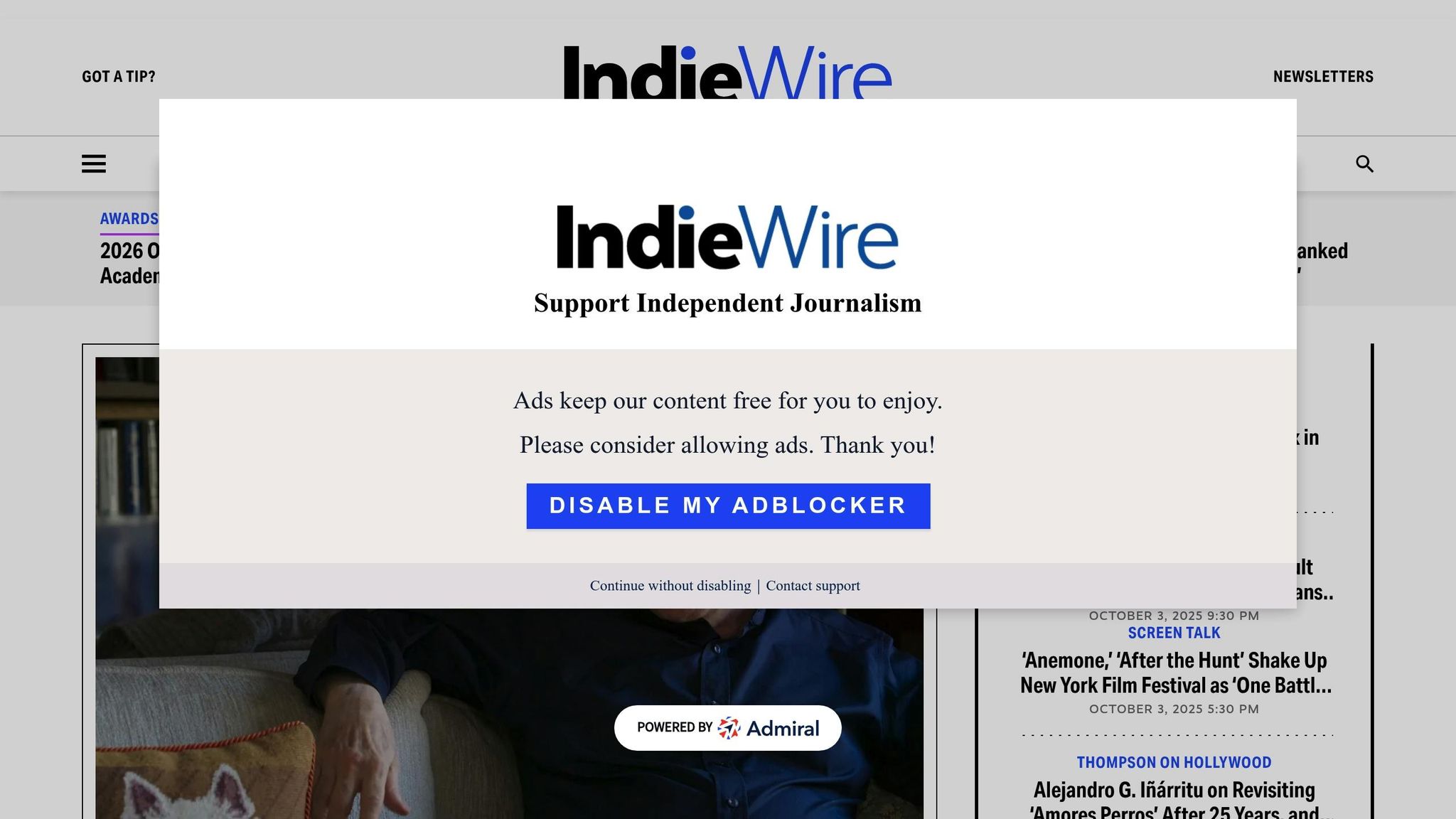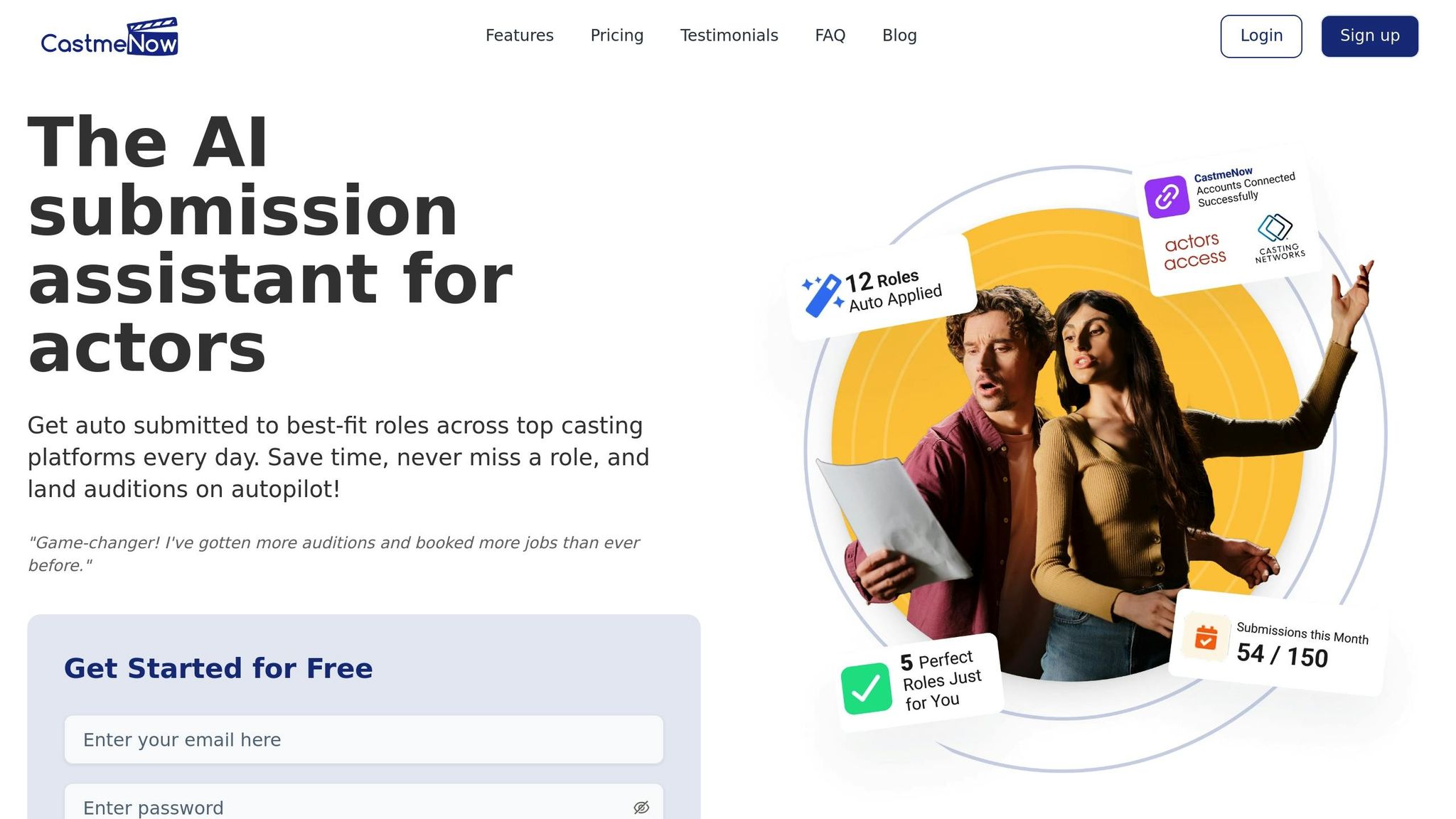Top Casting Insights from Audience Data
Explore how audience data and automation are reshaping casting decisions, helping actors align with viewer preferences for greater success.

In today’s entertainment industry, casting decisions are driven by audience data rather than just intuition. Platforms like CastmeNow use automation and analytics to help actors align their profiles with audience preferences, saving time and increasing visibility. By analyzing trends in demographics, behaviors, and genre demands, actors can focus on roles that resonate with viewers and casting directors.
Key takeaways:
- Audience segmentation (age, gender, location, interests) shapes casting choices.
- Genre trends reveal what audiences expect from drama, comedy, action, horror, and sci-fi.
- Timing matters: Submitting applications early improves chances of being noticed.
- Tools like CastmeNow automate submissions and track performance data, helping actors refine their approach.
Actors who use data-driven strategies and automation can apply smarter, faster, and more effectively, increasing their chances of consistent bookings.
Get Real-Time Audience Data with KINO Digital Premieres at IndieWire's Future of Filmmaking Summit

Main Audience Segmentation Methods for Actors
Breaking down audiences into segments helps actors align with viewer preferences and stay relevant as trends evolve. These strategies also guide casting choices, ensuring projects resonate with their target audience.
Age, Gender, and Location-Based Segmentation
Demographics play a pivotal role in determining a project's success. Factors like age, gender, ethnicity, and location shape audience preferences and, by extension, casting decisions.
Take 2023 as an example: films featuring 31%-40% people of color achieved the highest global box office earnings. Additionally, female and BIPOC moviegoers led opening weekend domestic ticket sales for several major films. These figures underscore the importance of authentic representation - not just as a social priority but as a financially sound strategy.
Regional productions often demand actors who reflect local identities and cultures. Casting directors now frequently analyze an actor's social media audience to ensure their followers align with the project’s demographic goals.
Interest and Behavior-Based Segmentation
Demographics tell part of the story, but understanding audience behavior adds another layer. Behavioral segmentation dives into how viewers interact with content - what genres they gravitate toward and their viewing habits. For instance, certain genres naturally appeal more to specific audience groups, and these preferences can shift over time.
Actors can use this knowledge to fine-tune their audition materials, ensuring they align with current tastes. Tools like CastmeNow enhance this process by leveraging automation to match actors with roles that fit both their skills and trending audience interests. This data-driven approach streamlines casting, benefiting both actors and filmmakers.
Audience Behavior Patterns by Genre
Understanding how audiences engage with different genres can give actors a leg up in their casting strategy. Preferences shift over time, influenced by cultural trends, generational changes, and the algorithms driving recommendations on streaming platforms.
Top Genres and What Audiences Want
Drama continues to dominate because viewers crave rich, layered storytelling. Audiences are drawn to character-focused narratives that delve into themes like mental health, family dynamics, and societal challenges. The popularity of shows such as Euphoria and This Is Us highlights the power of emotionally authentic stories that deeply connect with viewers.
Comedy has evolved to favor humor that’s both self-aware and inclusive. Younger audiences, particularly Gen Z, enjoy comedy that addresses real-world issues while staying relatable. Traditional sitcoms are giving way to dramedies that skillfully balance humor with emotional resonance.
Action and Thriller genres remain crowd-pleasers across all demographics. Casting trends show increased interest in diverse heroes and layered villains, as the classic action star mold expands to include talent from varying backgrounds, ages, and physical appearances.
Horror continues to captivate younger viewers, with psychological and supernatural elements leading the way. Audiences are drawn to fresh spins on familiar themes, and casting directors increasingly seek actors who can portray both vulnerability and resilience.
Science Fiction and Fantasy are steadily gaining ground, fueled by blockbuster franchises and advancements in production quality. These genres open the door for bold casting choices, offering opportunities to break away from traditional roles through imaginative storytelling and world-building.
These trends highlight the importance of tailoring your casting materials to fit specific genre demands.
Updating Your Materials Based on Current Trends
To stay competitive, your casting materials - headshots and demo reels - must reflect the energy and expectations of today’s audiences. For drama, casting directors prioritize materials that showcase emotional depth and authenticity. In comedy, it’s all about highlighting your personality and relatability, while action-focused materials should emphasize confidence, physicality, and character complexity.
Investing in genre-specific training can also make a big difference. Whether it’s scene study, improvisation, or stage combat, these skills can help you stand out. Platforms like CastmeNow make it easier to keep your materials in sync with evolving trends. Their automation tools ensure that your profiles across multiple casting platforms are always up to date, saving you the hassle of manual updates. Plus, the platform’s matching algorithms take current genre preferences into account, helping you connect with the right opportunities at the right time.
The most successful actors know the value of variety. Using diverse headshots and tailored reels for different genres can significantly boost your casting potential.
How to Use Audience Data in Your Casting Approach
Take a closer look at your submission history and response rates to turn audience insights into actionable casting strategies.
Best Times and Methods for Role Applications
When applying for roles, timing can make all the difference. Submitting your application shortly after a casting notice goes live not only demonstrates enthusiasm but also increases the chances of your profile being seen before the flood of entries begins. Beyond timing, the way you present your materials matters. Ensure your portfolio and application content are formatted for easy viewing across different devices - this can make a big impression on casting directors. Experiment with submission times to find what works best for your profile and use this data to refine your approach. These strategies can also help you make the most of automation tools.
How CastmeNow Provides Automation and Data Tracking

CastmeNow takes the hassle out of role applications by automating the process and offering detailed analytics. Its smart role-matching algorithms analyze trends and genre preferences to suggest roles that align with your profile and career goals. The platform also tracks which applications get the best responses, helping you fine-tune your strategy based on real data.
With integrated analytics, CastmeNow pulls data from connected casting profiles - like those on Casting Networks and Actors Access - into one place. This makes it easy to track key metrics such as response rates, callback percentages, and booking ratios. If you're curious about how this can improve your casting game, the platform offers a free 30-day trial to explore its features without any upfront cost.
Combining Data from Different Platforms
Bringing together data from multiple sources can sharpen your casting strategy even further. Use analytics from casting profiles and social media to identify trends and preferences. For instance, if behind-the-scenes content tends to get more engagement on your social channels, it might be a clue to incorporate that style into your audition materials.
Performance data from casting platforms can also reveal valuable insights. Metrics like how often your headshot is clicked or how many people watch your demo reel to the end can highlight what’s working and what needs improvement. CastmeNow simplifies this process by consolidating all your performance data into a single dashboard. This streamlined approach creates a cycle of continuous improvement - every adjustment you make based on data helps refine your strategy, leading to better results over time.
Conclusion: Using Data and Automation for Better Casting Results
The entertainment industry is increasingly leaning on data-driven strategies, giving actors who adapt to this trend a clear edge. By understanding audience preferences, genre trends, and the best times to submit applications, actors can transform their submissions into well-planned, strategic efforts.
Automation tools like CastmeNow simplify the process by eliminating the repetitive tasks that often hold actors back from applying to more roles. With features that automatically submit applications 24/7 on platforms such as Casting Networks and Actors Access, actors can stay visible without sacrificing precious time needed for auditions or honing their craft. The platform’s role-matching capabilities ensure applications align with individual career goals, while its analytics dashboard provides valuable performance insights.
Success in this field comes from combining audience insights with consistent, targeted applications. When you understand what casting directors look for in specific genres or demographics, automation ensures you’re always in the mix at the right time and scale.
FAQs
How can actors use audience insights to boost their casting success?
Actors can increase their chances of landing roles by tapping into audience insights to figure out which characters and stories resonate with different groups. By examining factors like age, location, and preferences, they can tailor their casting approach to align with what audiences want, making their performances feel more personal and engaging.
This data-driven approach also allows actors to present themselves as the perfect fit for roles aimed at specific audience segments. Not only does this boost their likelihood of being cast, but it also helps create projects that strike a stronger chord with viewers.
Why is timing important in the casting process, and how can actors make the most of it?
Timing plays a crucial role in the casting process. Submitting your application early can often increase your chances of catching a casting director's attention. Casting calls tend to fill up fast, so being proactive is absolutely essential.
Here’s how actors can make the most of their timing:
- Apply as soon as opportunities go live. The earlier you submit, the better your chances of standing out.
- Track casting deadlines carefully. Missing a deadline means missing an opportunity, so stay organized.
- Leverage tools like CastmeNow. This platform automates applications around the clock, ensuring you never miss a shot at applying quickly.
By staying on top of deadlines and using automation tools, actors can enhance their visibility and increase their chances of booking roles.
How does CastmeNow help actors improve their casting strategy?
CastmeNow transforms the way actors approach casting by streamlining the application process. It automates submissions, making them quicker and more consistent, which means actors can spend less time buried in administrative tasks and more time perfecting their craft.
What really sets CastmeNow apart is its ability to track and analyze data. By offering insights into audience preferences and casting trends, it empowers actors to sharpen their focus, make informed decisions, and improve their chances of landing roles in an incredibly competitive field. This strategic use of data gives actors a clear advantage in navigating the casting world.

